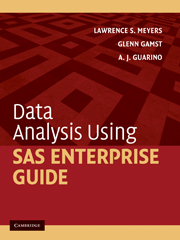Book contents
- Frontmatter
- Contents
- Preface
- Acknowledgments
- I Introducing SAS Enterprise Guide
- II Performing Analyses and Viewing Output
- III Manipulating Data
- IV Describing Data
- V Score Distribution Assumptions
- VI Correlation and Prediction
- VII Comparing Means: The t Test
- VIII Comparing Means: ANOVA
- IX Nonparametric Procedures
- 27 One-Way Chi-Square
- 28 Two-Way Chi-Square
- 29 Nonparametric Between-Subjects One-Way ANOVA
- X Advanced ANOVA Techniques
- XI Analysis of Structure
- References
- Author Index
- Subject Index
27 - One-Way Chi-Square
Published online by Cambridge University Press: 05 June 2012
- Frontmatter
- Contents
- Preface
- Acknowledgments
- I Introducing SAS Enterprise Guide
- II Performing Analyses and Viewing Output
- III Manipulating Data
- IV Describing Data
- V Score Distribution Assumptions
- VI Correlation and Prediction
- VII Comparing Means: The t Test
- VIII Comparing Means: ANOVA
- IX Nonparametric Procedures
- 27 One-Way Chi-Square
- 28 Two-Way Chi-Square
- 29 Nonparametric Between-Subjects One-Way ANOVA
- X Advanced ANOVA Techniques
- XI Analysis of Structure
- References
- Author Index
- Subject Index
Summary
Overview
Chi-square is classified as a nonparametric statistic, a class of statistics described in Section 15.3.2 when we discussed the Spearman rho correlation. The procedure is applied to categorical variables as described in this chapter and the following one. Chi-square was developed in 1900 by Karl Pearson (Pearson, 1900) as the solution to finding a goodness-of-fit test on nonnormal distributions (only quantitative variables can be described by the normal curve).
In the simplest application of chi-square, we apply the chi-square test to the frequency data associated with the categories of a single variable; such a design is known as a one-way chi-square design. The data consist of frequencies of occurrences for each category, and our intent is to determine if those frequencies are distributed as we would expect (expected frequencies for the categories) if only chance influenced the outcome.
The expected frequencies in a chi-square analysis constitute the null hypothesis or the model against which the chi-square statistic is tested. The issue is whether the data fit, that is, conform to, the model or if they significantly diverge from the model; in this sense, the chi-square test can be thought of as a goodness-of-fit test assessing how well the model fits the data.
The crux of the chi-square procedure lies in formulating the expected frequencies to which the observed frequencies are compared. In general, there are three strategies that are commonly employed to generate the expected frequencies of the categories: equal frequencies, preestablished frequencies, and mathematically modeled frequencies.
- Type
- Chapter
- Information
- Data Analysis Using SAS Enterprise Guide , pp. 269 - 278Publisher: Cambridge University PressPrint publication year: 2009



